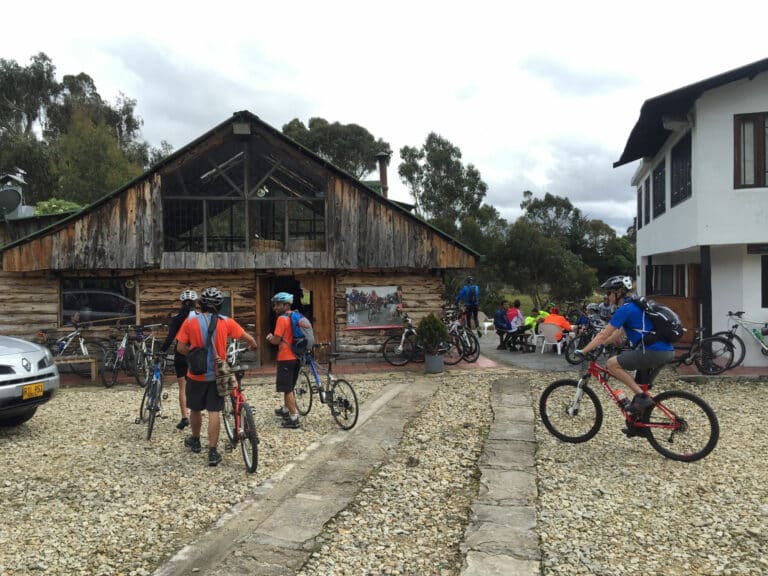Essential Skills from the Appalachian Bike Institute
If you’re reading this article, there’s a good chance you own a bike. There’s also a good chance that if you own a bike, you have absolutely no idea how to take care of it.
Don’t worry, you’re not alone. For most of us, bikes, like the internal combustion engine and the opposite sex, are a mystery.
Jenny Kallista is working hard to solve that mystery. The veteran bike mechanic (trained at the Barrett Bike Institute in Colorado) taught classes at an Asheville bike shop for six years, helping bike owners learn how to fix flats and adjust brakes.
Now, she is taking it to the next level. In October, Kallista opened the Appalachian Bike Institute, the first bike school east of the Rockies. Through intensive weekend classes, Kallista will help pros, amateur bikers, and working mechanics have a greater understanding of the machine between their legs. There are only two other bike schools like it in the entire country.
BRO talked to Kallista about her obsession with circles and kicking ass in a man’s world. She also shared some essential bike advice that even non-mechanical people can easily comprehend.
Why open a bike institute? Why not just keep teaching intro to maintenance classes?
The whole point of the school is to bring people a better understanding of their bikes, both pros and amateurs. There are plenty of people out there riding bikes without knowing how the bike actually works. They just pedal and keep their eyes on the road ahead of them. Even within the professional world of bike mechanics, there’s a lot of mystery to certain aspects of the bike, like wheel building. Being able to build wheels gives you special status in the mechanic’s world. Wheel builders are like gurus. So I’m offering a class on wheel building. The whole idea was to demystify things. Bike maintenance doesn’t have to be difficult. It can actually be fun.
Tell us about your overhaul class.
In that class, students learn how to tear their bike apart and put it back together. They’ll learn how to replace the whole drive train, the whole cable system. They’ll learn how to true wheels, adjust brakes…It’s an intense class, eight hours a day for two days, but students will come out of it with a full understanding of how their bike works. Think about the money that knowledge will save you. Most bikers pay $60 or $75 for a basic tune-up.
Is bike mechanics science or art?
I think it’s both. My background is in art—previously I’ve worked as a professional glass blower, welder, and steel sculptor— but I studied under John Barnett, whose underlying principle is “bike mechanics is science, not art.”
Bike mechanics is like making dinner. You can follow the recipe exactly, or you can put your own stamp on the meal. I’ve always had an interest in how things work, but what really draws me to bikes is the fact that I’m fascinated by things that are circular and by centrifugal force. In the bike world, I’m known for wheel building, and that’s where I get to indulge in that fascination. The tension in the spokes to get that wheel perfectly straight and true—there’s an art to that.
I’d imagine you’re one of the few female bike mechanics in town.
For a long time, I was the only female mechanic in town. Now there are two. Every year that goes by, you’ll see more and more of them. Women make great bike mechanics because of our innate attention to detail. Working on a bike isn’t as difficult as people think, but it’s extremely detailed work. And let’s face it, women are generally very detail-oriented.

THREE GOLDEN RULES
Kallista says the average biker can keep their steed in shape without ever having to pick up a tool. Here are Kallista’s three keys for maintaining your bike without ever turning a wrench.
1. get your bearings
Know how to identify loose bearings. If you can detect even a little bit of knocking or play in a bearing, you need to get it adjusted. If a bearing is loose, it can quickly lead to a breakdown in the components.
Anywhere the bike parts move freely is going to have bearings, but there are a couple of bearings that you really need to pay special attention to: the headset and the bottom bracket.
The headset is how you control the steering on your bike. Test for loose bearings by grabbing the front brake and wiggling the handlebars, then turn the handlebars to the side and wiggle them. If you feel any play or knocking in the headset, you need a bearing adjustment.
The bottom bracket holds the bearings that the cranks revolve around. If you feel any side to side rocking or knocking in your pedaling, it means you have loose bearings. There should be no play in the pedal stroke whatsoever.
2. K.I.D.S. (keep It dirty, stupid)
Bikers should really stop washing their bikes. The less water your bike sees, the longer that bike will last. After riding through muddy conditions, people’s first instinct is to hose off the bike. That’s the worst thing you can do for the components, especially if you’re using any sort of water pressure, which will wash all the grease out of your components. Even a nozzle on a garden hose is too much pressure. Your bike has sealed bearings in your suspension fork, bottom bracket, and rear suspension. Those seals are only designed to keep dirt out, not water. When you spray them with water, you’re stripping all of the grease out of those delicate parts.
The best way to clean your bike is to gently rinse the frame and tires with a hose then wipe the mud away with a towel. Then wet a toothbrush and scrub the dirt away from your drive train. That will keep the components clean without damaging them. If that’s too much work for you, then simply let all the mud dry on your bike, knock off the big chunks of dirt, lube the chain, and ride.
3. get anal about lube
Set up your bike so you can freely backpedal, and put the chain ring in the middle gears of the drive train. Start backpedaling your bike, and point the nozzle of your lube along the inner edge of the chain. If you just put lube in the middle of the chain, where the rollers are, the lube will simply drip out and do you no good. You want about one drop per link, so do a full rotation lubing the outer edge of the chain, then another full rotation lubing the inner edge of the chain. I like to use Prolink lube, which is thin, clean, and has a built-in detergent so it cleans while it lubricates. After the lube is on the chain, get a cotton rag, grab the chain at the bottom, and run the chain through the rag over and over to get all the excess lube and dirt off the chain. The detergent in Prolink will actually purge the dirt as you wipe it down. You want to get the chain as clean and dry as you can. Do not lube it again. If you have excess lube on your chain when you ride, you’ll collect gunk on your chain and cassette. •
BIKE ANATOMY 101

1. Cassette
Toothed cogs that make up the gears attached to the rear wheel.
2. Rear Derailleur
The mechanism that moves the chain from one gear to another, found below the rear dropout.
3. Chainstay
A section of the frame that connects bottom bracket to rear dropout.
4. Seat Stay
The part of the frame that connects the top of the seat tube to the rear dropout.
5. Front Derailleur
The mechanism that moves the chain from one chain ring to another.
6. Bottom Bracket
Includes the pedal axle and bearings.
7. Chain Rings
Toothed rings that directly connect to the crank.
8. Crank
Connects the pedals to the chain ring.
9. Pedal
Where the foot is placed to crank the chain ring.
10. Frame
The main component of a bicycle, onto which wheels and other components are fitted.
11. Down Tube
Frame tube that connects the bottom bracket to the head tube.
12. Headset
The components that allow the handlebar to rotate and steer the fork.
13. Head Tube
Contains the headset, the interface with the fork.
14. Front Suspension Fork
Holds the front wheel and provides shock absorption so the rider can keep the front wheel on the ground and maintain steering control over the bike.
15. Dropouts
The slots on the frame and fork that hold the wheel axles.







